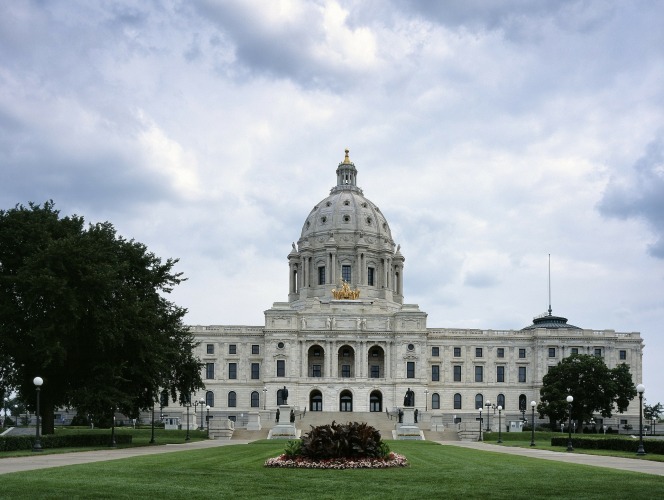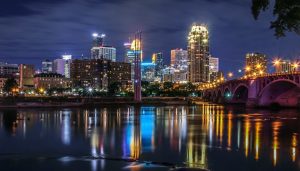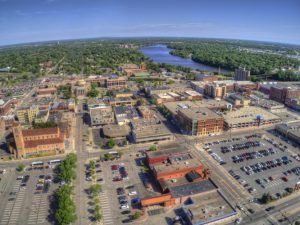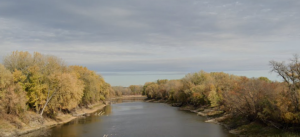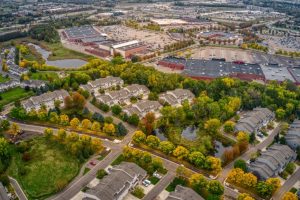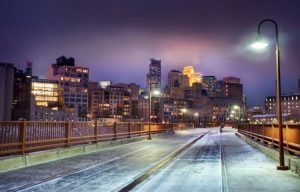 Minnesota : Safety by City
Minnesota : Safety by City
- Bemidji
- Brainerd
- Brooklyn Park
- Detroit Lakes
- Duluth
- Ely
- Fergus Falls
- Grand Marais
- Grand Portage
- International Falls
- Lanesboro
- Mankato
- Maple Grove
- Minneapolis
- New Ulm
- Pipestone
- Red Wing
- Shakopee
- St. Cloud
- St. Paul
- Two Harbors
- Winona
- Woodbury
Saint Paul is the smaller of the twin cities in Minnesota with 311,000 people.
Its twin, Minneapolis, has 429,000.
Saint Paul is the older of the two and the state capital.
It has the Minnesota Science Museum, known for its dinosaur specimens.
It has a large history center with interactive exhibits.
Its large zoo is free to the public.
It is a more historical and more laid-back city than Minneapolis.
It was a trading post that was chosen as a state capital when Minnesota became a state.
The city is at the confluence of the Mississippi, Minnesota, and St. Croix river, which made it a natural spot for a trading center.
Saint Paul has many tree-lined neighborhoods, a lot of Victorian architecture, and some small colleges.
Saint Paul was originally settled by French, Irish, and German Catholic immigrants.
It has a lot of historic buildings in the downtown area, along with a lot of older homes that give it a pleasant atmosphere.
Warnings & Dangers in St. Paul

OVERALL RISK: MEDIUM
St. Paul has a higher crime rate than the state and national averages, both in violent and property crimes. It has a lower crime rate than Minneapolis. Like many good-sized cities, St. Paul has its good and bad areas. Some areas should be avoided at all times. Most of the tourist-type areas are very safe during the day, and not overly dangerous at night.

TRANSPORT & TAXIS RISK: LOW
Taxis are available throughout the city. They are licensed and safe. There is more danger of a taxi driver getting robbed. It has a growing light rail system and a strong bus system. It is very inexpensive, and there are free-ride buses in some areas of downtown. It is consistently ranked in the top 10 nationally as one of the best public transport systems.

PICKPOCKETS RISK: LOW
Pickpockets are not common in Saint Paul or the Twin-Cities in general. It is a tourist area where crowds gather though, and that makes it a good area for a pickpocket to operate in. Keep your belongings safe, and avoid having your wallet or purse where it can easily be reached. With some basic common sense, you should not have a problem in this area.

NATURAL DISASTERS RISK: LOW
There have been tornadoes in this area as well as flooding. The relatively flat area of the plains makes it susceptible to both. There have not been any serious events rising to the level of disaster in recent years, so the risk may not be that great. Snow can get very heavy in the winter. Watching out for the weather any time of year is a good idea.

MUGGING RISK: MEDIUM
While the tourist areas are relatively safe, it has the problems many cities of this size have. There are some bad areas where you would likely be mugged if you went alone, even in the daytime. If you stick to the tourist areas and do not go out alone at night, you should not have any problem. There is a slight risk, however, and it's good to keep your eyes open.

TERRORISM RISK: LOW
While it is a major tourist area with a lot of people, there have not been any significant terrorist events in Saint Paul. There have been concerns about rioting and terrorism from extremist groups within the United States, but so far there have not been any major issues. Be aware of your surroundings though, and stay alert because it could happen even if not likely.

SCAMS RISK: LOW
There are instances where people seek petition signers and donations through deception, but there are not a lot of public scams. Occasionally, a taxi driver will take the long way to your hotel, or your hotel might overbook as part of a scam. Many scammers operate online and try to steal identities to crack people's bank accounts, but this is not limited to any location.

WOMEN TRAVELERS RISK: LOW
Women traveling, even alone, are generally safe in the Twin-Cities. This is true as long as you stay in the tourist areas and take normal precautions. Going out at night alone increases your chances of being a crime victim dramatically. There is no indication there is more danger for women than men. Take the same precautions you would at home.

TAP WATER RISK: LOW
Minnesota is the land of 10,000 lakes, and it has a lot more than that. There is plenty of quality fresh water in the state and the Twin-City area. Water is supplied by the city and meets or exceeds all state and national guidelines. You can drink tap water in Saint Paul without concern.
Safest Places to Visit in St. Paul
The safest places in St. Paul are parks and other tourist areas.
Minnehaha Falls is part of the Mississippi National River Recreation area.
It is part of a scenic byway system created in the 1800s.
You will forget you are in a city with all the nature to explore.
A walking tour of Victorian homes along Summit Ave is also popular and safe.
The St. Paul Gangster Tour is also safe and fascinating.
The southeast part of the city is the safest.
The science museum and the observatory are also interesting sights.
The Cathedral of St. Paul is surrounded by statues of saints from around the world.
Historic Fort Snelling and the state capital buildings are also well worth a tour and are very safe areas.
Areas around the river have the highest crime rates, but few people live there, so any crime at all would raise the rate.
Places to Avoid in St. Paul
Saint Paul’s crime rate is above the national average, so there are some bad areas.
Saint Paul ranks at the 84th percentile, meaning 84 percent of cities of the same size nationally are safer.
Your chances of being a crime victim are one in 66 in the southwest part of town, and one in 482 in the southeast.
The western part of town also has a high crime rate.
The Thomas Dale section near the Mississippi River has a crime rate 168 percent higher than the national average, and 200 percent above the violent crime rate.
At night especially, the downtown section has a crime rate 300 percent higher than the national average.
The north-central section, and onward to Minneapolis are the most dangerous areas in general.
Safety Tips for Traveling to St. Paul
- Careful parking. Park your car in well-lit areas in the main parking lots. Car theft is a problem here, and leaving a car in a dark area by itself makes it vulnerable to theft. Avoid any indication that your car is a rental vehicle, as they are primary targets.
- Lock your car. As obvious as this is, people sometimes forget, and they have things stolen. Thieves walk parking lots checking doors. They will normally pass up a locked car, but if they find one open they will steal what they can.
- Cover up your stuff. Even locking your car does not guarantee your property is safe. Don’t leave electronics, or things like a portable GPS, out in the open. Cover valuables with a towel, or put them under the seat or in the trunk. In high-theft areas, people will break windows to take things of value.
- Study the area. Before you go, look at crime maps to see where the high crime areas are. Learn the basic areas of the city so you can avoid them. Also, ask your hotel what areas should be avoided. Some areas are unsafe even in the daytime and there is no reason to go there.
- Don’t be obvious. Avoid looking like a tourist. Criminals will target a tourist because they are not as familiar with the area. Try to blend in with the people around you and look as much like a local person as you can.
- Act confident. Always act like you know where you are and where you are going, even if you do not. Avoid opening up big maps, which signal that you are a tourist. Use your phone for directions. It’s OK to ask for directions, but try to avoid letting anyone see that you are lost or disoriented.
- Watch the weather. Storms can come in summer, and snow can come suddenly in winter. Keeping abreast of weather predictions will help keep you from getting caught out in the rain. Pay heed to any warnings given.
- Watch your drink. If you are out at night in a club, don’t accept open drinks, or drink from a bottle you did not open yourself. Some bad people will drug drinks. They are rare, but it is better to be careful and be safe.
- Stay on the path. Avoid wandering too far off the beaten path of tourist areas. These areas may be safe, but there may be bad areas nearby. This is especially true at night, but it is also a good idea during the day.
- Don’t go alone. It is a good idea to never go alone any time of day, but you would be fine with a tour group. Especially at night, you should not be out alone in an area you are not familiar with, even if it has a safe reputation.
So... How Safe Is St. Paul Really?
Like many larger cities, St. Paul has some nice and safe areas.
It also has some very bad areas that are not even safe in the daytime.
The crime rate is rather high overall, and the city does not have the best reputation.
The violent crime rate is 7.82 per 1,000 people.
The state average is 1.7 and the national average is around four.
Property crime is also a major issue, which is twice the national average.
The property crime rate is 40 per 1,000, while the national average is 19, and the state average is 21.
The assault and robbery rates are at least twice the national averages.
Rape is almost twice the national average.
At least murder is just slightly higher than the national average.
Car theft is a big problem in some areas, with a 9.47 per 1,000 rates, while the national average is 2.45 per 1,000.
Petty theft and burglary are also above the national average.
Even though the crime rate is relatively high in St. Paul, it is worse in Minneapolis.
It is about 15 percent higher in Minneapolis.
Much of the rest of the state has a lower than the national average rate.
How Does St. Paul Compare?
| City | Safety Index |
|---|---|
| St. Paul | 64 |
| Los Angeles | 56 |
| Oakland | 57 |
| New Orleans | 57 |
| Baltimore | 56 |
| Boston | 67 |
| Washington DC | 56 |
| Siem Reap (Cambodia) | 63 |
| Phnom Penh (Cambodia) | 61 |
| Niagara Falls (Canada) | 87 |
| Calgary (Canada) | 82 |
| Buenos Aires (Argentina) | 60 |
| Vancouver (Canada) | 82 |
Useful Information

Visas
You need a visa to enter the United States. Once in the country, you will not need it to move around or to go to St. Paul.

Currency
The currency is the U.S. Dollar. You may do currency exchange at the airport or any bank. You may also use credit cards from anywhere around the world.

Weather
Summers can get hot, but usually not overbearing. Winters can be very cold with lots of snow. Dress warmly in the winter and pay attention to the wind chill.

Airports
There is a regional airport downtown, and an international airport about eight miles south of town. Taxis and buses run regularly from there into town.

Travel Insurance
You hope you will never need your travel insurance, but it will give you peace of mind that you will be protected if something bad happens.
St. Paul Weather Averages (Temperatures)
Average High/Low Temperature
| Temperature / Month | Jan | Feb | Mar | Apr | May | Jun | Jul | Aug | Sep | Oct | Nov | Dec |
|---|---|---|---|---|---|---|---|---|---|---|---|---|
| High °C | -5 | -2 | 5 | 14 | 21 | 26 | 28 | 27 | 22 | 15 | 5 | -3 |
| Low °C | -14 | -11 | -5 | 2 | 9 | 14 | 17 | 16 | 11 | 4 | -3 | -11 |
| High °F | 23 | 28 | 41 | 57 | 70 | 79 | 82 | 81 | 72 | 59 | 41 | 27 |
| Low °F | 7 | 12 | 23 | 36 | 48 | 57 | 63 | 61 | 52 | 39 | 27 | 12 |
Minnesota - Safety by City
| City | Safety Index |
|---|---|
| Bemidji | 78 |
| Brainerd | 72 |
| Brooklyn Park | 57 |
| Detroit Lakes | 82 |
| Duluth | 78 |
| Ely | 84 |
| Fergus Falls | 78 |
| Grand Marais | 80 |
| Grand Portage | 80 |
| International Falls | 77 |
| Lanesboro | 82 |
| Mankato | 82 |
| Maple Grove | 84 |
| Minneapolis | 51 |
| New Ulm | 83 |
| Pipestone | 81 |
| Red Wing | 78 |
| Shakopee | 81 |
| St. Cloud | 52 |
| St. Paul | 64 |
| Two Harbors | 83 |
| Winona | 86 |
| Woodbury | 83 |
